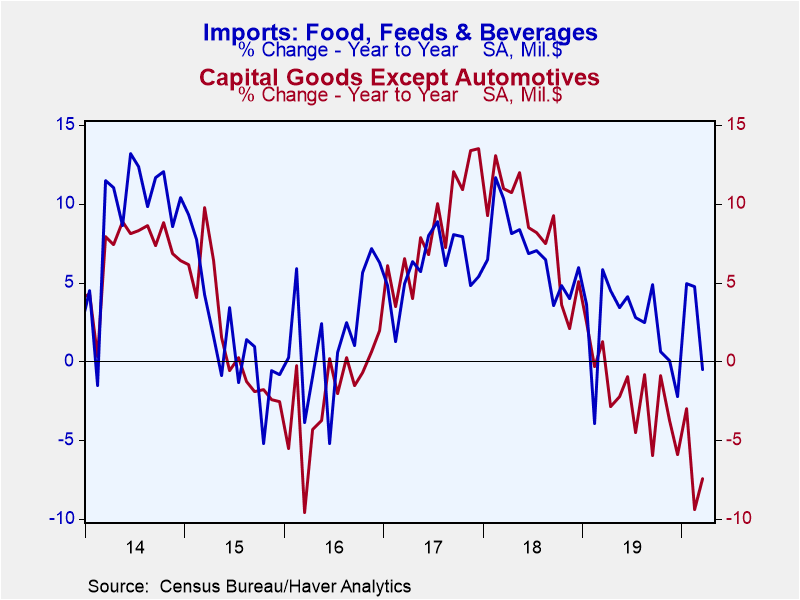 Global| Apr 28 2020
Global| Apr 28 2020Advance U.S. Trade Deficit in Goods Deepens in March
by:Tom Moeller
|in:Economy in Brief
Summary
• Exports and imports decline sharply. • Export weakness was broad-based. • Import declines were mixed amongst product categories. The advance estimate of the U.S. trade deficit in goods grew to $64.22 billion in March from $59.88 in [...]
• Exports and imports decline sharply.
• Export weakness was broad-based.
• Import declines were mixed amongst product categories.
The advance estimate of the U.S. trade deficit in goods grew to $64.22 billion in March from $59.88 in February. A $53.6 billion deficit had been expected in the Action Economics Forecast Survey.
Exports of goods declined 6.7% m/m (-8.9% y/y) in March following a 0.7% rise. The m/m weakness reflected declines in each of the export categories. Motor vehicles & parts exports weakened 17.8% (-18.8% y/y) in March after two months of strong increase. Exports of "other" goods fell 8.1% (-4.2% y/y) last month following a 5.3% February increase. Industrial supplies exports were off 7.5% (-5.1% y/y) after rising 1.6%. Exports of nonauto consumer goods weakened 5.0% (-5.4% y/y) after falling 4.2%. A 4.3% decline (-9.8% y/y) in capital goods exports came after edging 0.5% higher in February. Foods, feeds & beverages exports eased 0.1% (+0.7% y/y), off slightly for the second consecutive month.
Imports of goods fell 2.4% (-9.6% y/y) in March, about the same as they did in February. The decline was led by a 9.0% falloff (-12.8% y/y) in imports of automotive parts & engines which followed a 4.8% rise. Nonauto consumer goods imports weakened 8.3% (-14.9% y/y) after falling 2.1%. Increases were posted last month in all other import categories. Capital goods imports improved 2.7% (-7.4% y/y) after falling for two months. Foods, feeds & beverage imports rose 3.4% (-0.5% y/y) and reversed February's shortfall. Imports of "other" merchandise improved 2.7% (5.3% y/y), about as they did in February. Industrial supplies & materials imports gained 0.4% (-9.4% y/y) following two months of sharp decline.
The advance international trade data can be found in Haver's USECON database. The expectation figure is from the Action Economics Forecast Survey, which is carried in AS1REPNA.
| Advance U.S. Foreign Trade in Goods (Current Customs Value $) | Mar | Feb | Jan | Mar Y/Y | 2019 | 2018 | 2017 |
|---|---|---|---|---|---|---|---|
| U.S. Trade Deficit ($ bil.) | 64.22 | 59.88 | 65.90 | 71.45 (03/19) |
852.79 | 874.81 | 793.41 |
| Exports (% Chg) | -6.7 | 0.7 | -1.1 | -8.9 | -1.2 | 7.7 | 6.5 |
| Imports (% Chg) | -2.4 | -2.5 | -1.9 | -9.6 | -1.7 | 8.6 | 7.0 |
Tom Moeller
AuthorMore in Author Profile »Prior to joining Haver Analytics in 2000, Mr. Moeller worked as the Economist at Chancellor Capital Management from 1985 to 1999. There, he developed comprehensive economic forecasts and interpreted economic data for equity and fixed income portfolio managers. Also at Chancellor, Mr. Moeller worked as an equity analyst and was responsible for researching and rating companies in the economically sensitive automobile and housing industries for investment in Chancellor’s equity portfolio. Prior to joining Chancellor, Mr. Moeller was an Economist at Citibank from 1979 to 1984. He also analyzed pricing behavior in the metals industry for the Council on Wage and Price Stability in Washington, D.C. In 1999, Mr. Moeller received the award for most accurate forecast from the Forecasters' Club of New York. From 1990 to 1992 he was President of the New York Association for Business Economists. Mr. Moeller earned an M.B.A. in Finance from Fordham University, where he graduated in 1987. He holds a Bachelor of Arts in Economics from George Washington University.










